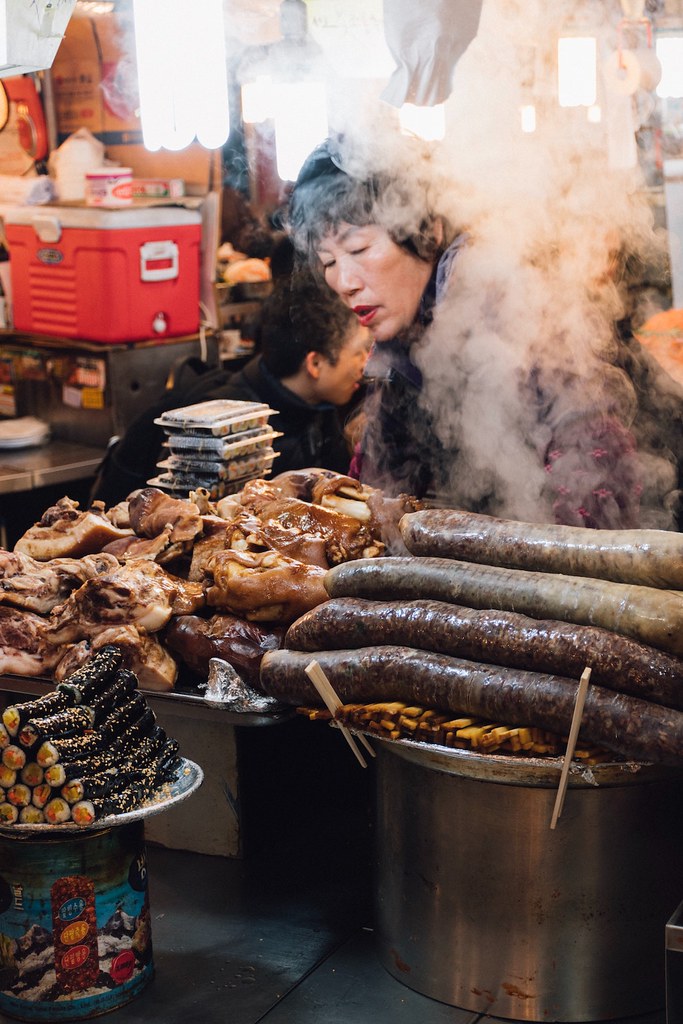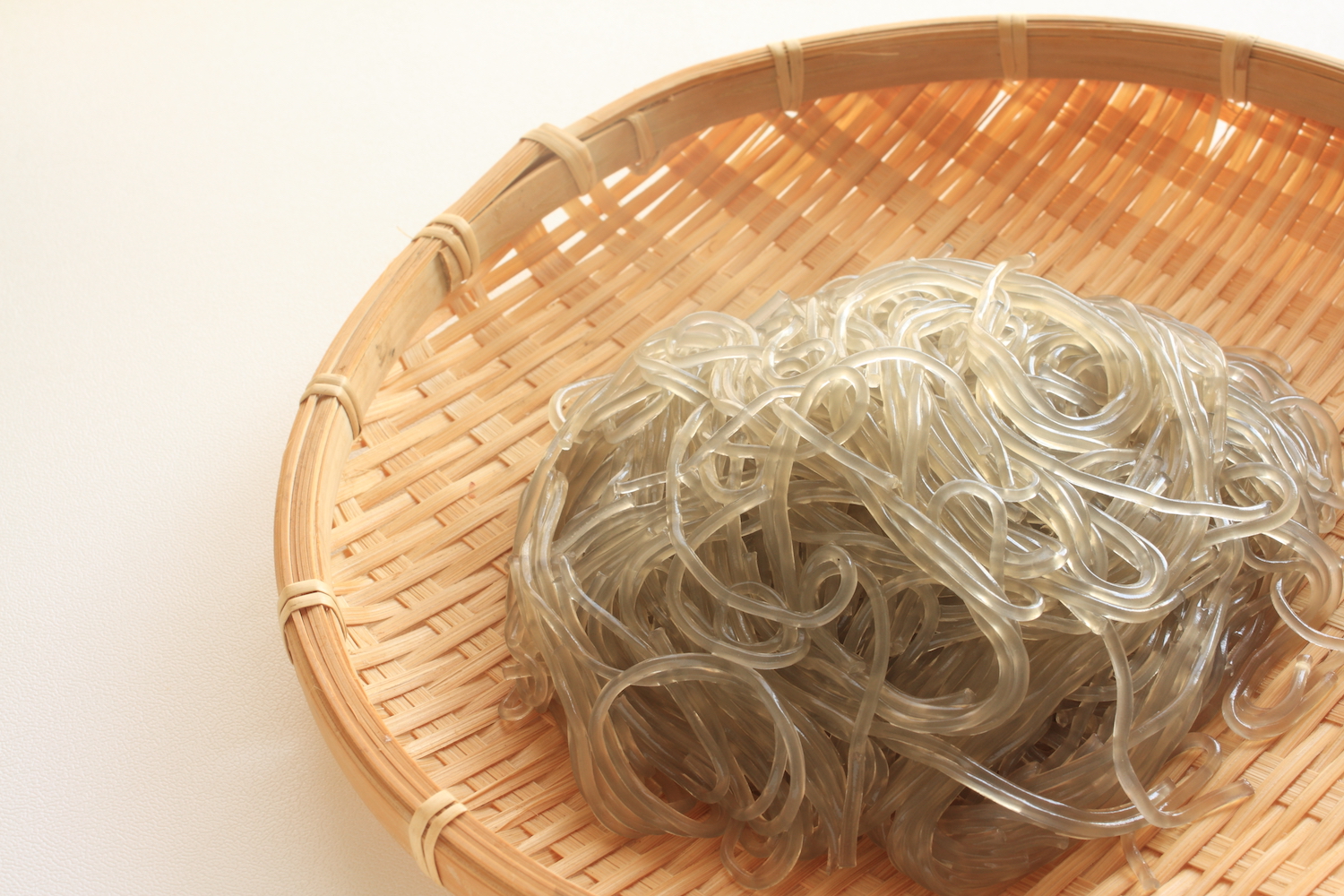This post may contain affiliate links. Please read my disclosure for details at the bottom of this page. As an Amazon Associate, I earn from qualifying purchases on this post about Korean dangmyeon (Sweet Potato Glass Noodles).
Dangmyeon (당면), also known as glass noodles, vermicelli noodles, cellophane noodles, and sweet potato noodles, is a type of Korean noodle made from purified sweet potato starch, water, and salt. People in South Korea use these noodles to make some of their most famous and popular dishes.
Here, we will take a deep dive into these Korean sweet potato noodles. Let’s get started!
Dangmyeon (Korean Glass Noodles) Characteristics:
When buying dangmyeon, it typically comes in dried form that has a slightly brown-grayish coloring. Once you cook the noodles, they become translucent. Further, when you mix them with other ingredients, they often take on the coloring of the sauces and spices.
For those unfamiliar with these glass noodles, you may be surprised by the texture and taste. Unlike other types of noodles, these have a chewy and springy texture. Once cooked, you can pull on these noodles and they will not break or tear easily.
Furthermore, Korean sweet potato noodles do not have much flavor. Instead, they take on the flavor of the sauces and other ingredients.
Dangmyeon Is Also Known As
Glass Noodles, vermicelli noodles, cellophane noodles, korean vermicelli, sweet potato noodles, sweet potato starch noodles, and more
Important Note: When grocery shopping, do not confuse dangmyeon with rice vermicelli noodles. Though you can find both of these noodles in the Asian section of the grocery store as well, one is made of rice while the other is made of sweet potato. Further, the flavor and texture are different.
How Do People Use Sweet Potato Noodles in South Korea?
In South Korea, people use these sweet potato noodles in a few different ways. Below, we list some of the most popular types of foods using dangmyeon.
- Japchae: Japchae is a savory stir-fried vegetable, protein, and sweet potato dish. People typically serve it as a side dish during important family holidays such as Chuseok.
- Gimmari (or Kimmari): This is a savory side dish or street food made by wrapping dangmyeon in dried seaweed and frying them.
- Andong Jjimdak: This is a soy-braised chicken dish that often includes sweet potato noodles as well!
- Sundae (or Soondae): Sundae is a type of blood sausage made as street food in both North and South Korea. Often, the sausage contains these glass noodles as well.
You can find these noodles in many other types of foods such as soups, stews, and dumplings!

Korean Japchae
Where Should I Buy Dangmyeon?
In the United States, many well-stocked grocery stores have started selling these noodles in the Asian section.
If you cannot find these sweet potato noodles in your local grocery store, you can find them in Asian markets such as H-Mart. Also, you can easily find these noodles on online retailers such as Amazon and Walmart.
If you have a small family-owned Asian market in your hometown, I highly recommend buying from there–Though it may be a bit more expensive, you are supporting a small family-owned business.
How Should I Store Glass Noodles?
Uncooked and dried, you can keep these noodles in a cabinet or pantry. They should remain sealed in an airtight container and a cool dry location away from hot sunlight.
Once cooked, you need to keep these noodles in an airtight container in the refrigerator. Depending on the ingredients mixed with the noodles, you can keep them up for a week in the fridge!

Photographed You Have Korean Street Food, Including Sundae. You Make Sundae (Blood Sausage) with Dangmyeon.
Dangmyeon Nutrition:
While these noodles contain similar calories and carbohydrates as your typical noodle, they do not cause spikes in your blood sugar. Unlike noodles made from wheat or rice, these contain low-glycemic ingredients.
While these noodles are good for those trying to keep their blood sugar stabilized, they do not contain many other healthy nutrients or benefits. So, don’t use these noodles to help fortify your diet!
Also, for those with major allergies to ingredients such as wheat, gluten, soy, these noodles are safe to eat. Korean sweet potato noodles do not contain any type of major allergen. Like we stated above, companies and restaurants typically make these noodles using sweet potato starch, salt, and water. In other words, these noodles are a Korean ingredient that is naturally safe for those with celiac
Note: Though these noodles do not contain major allergens, the dishes made using these noodles often do. Always check the packaging and ask about ingredients at restaurants if you have any allergies.
We Hope You Enjoyed Learning About The Korean Glass Noodles (Dangmyeon)!
In the end, we hope you enjoyed learning about Korean glass noodles (dangmyeon). If so, let us know in the comment section below. Also, if you cook with these noodles, what do you typically make?
If you would like to read more about cooking, you can find further recipes on our blog. We listed some of our favorite Carving A Journey Korean recipes below! For reference, many recipes are influenced by our blended Korean and Southern heritage.
Korean Ingredients:
Korean Sweet Potato Recipes:
- Andong Jjimdak: Braised Chicken with Sweet Potato Noodles
- How to Perfectly Bake a Korean Sweet Potato
Further Carving A Journey Korean Recipes:
- Greek Momo Recipe (Korean Breakfast Trend)
- Tteokkochi (Korean Rice Cake Skewers)
- Jumeokbap (Handmade Korean Rice Balls); And
- Bibimmyeon (Korean Spicy Cold Noodles)
If you have any questions or comments, you can also email us at [email protected].
And, finally, we would love to hear from you through our social media as well! You can follow us at @carvingajourney on Instagram, Twitter, Facebook, and Pinterest. Or, if you would like more articles like these, you can subscribe to our blog by joining our mailing list. We hope you enjoyed learning about Dangmyeon, otherwise known as Korean sweet potato noodles! Soon, we will be publishing more recipes using this Korean ingredient! Thank you so much for stopping by!
Carving A Journey is a participant in the Amazon Services LLC Associates Program, an affiliate advertising program designed to provide a means for sites to earn advertising fees by advertising and linking to Amazon.com. Although we may earn commissions for our endorsement, recommendation, testimonial, and/or link to any products or services from this website, these opinions are my own and I fully support these products.

